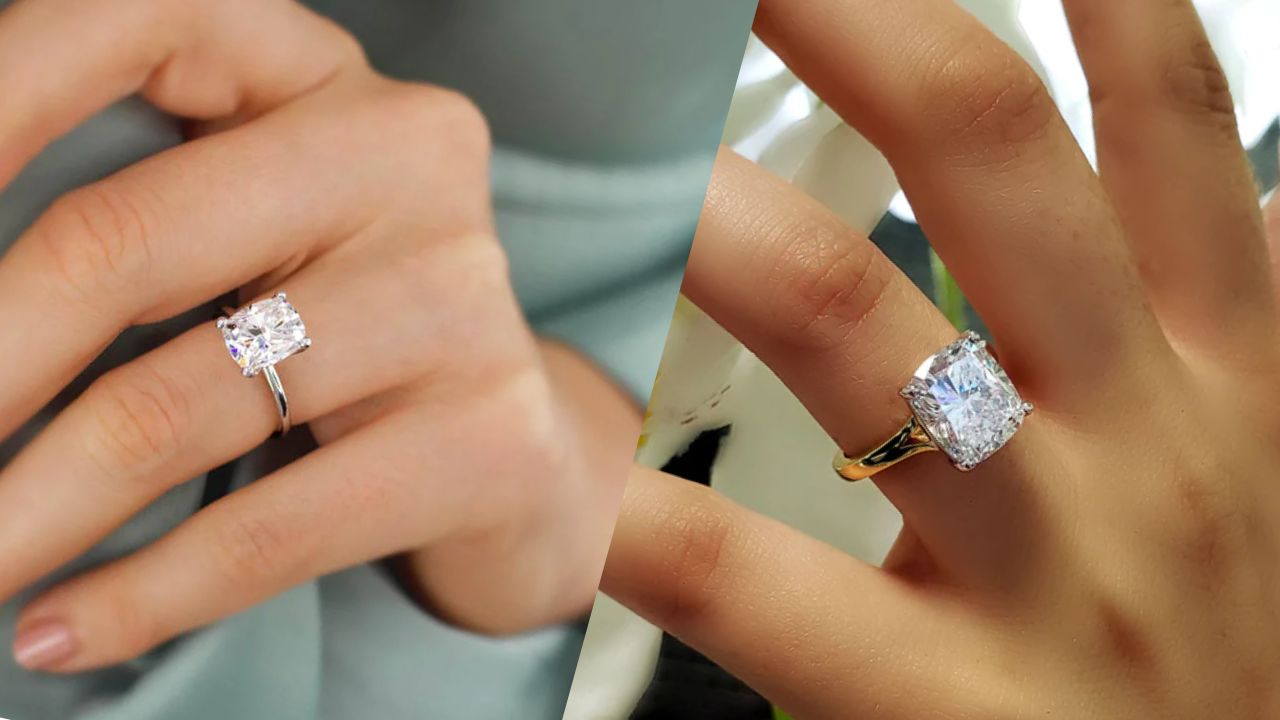Moissanite is the form that a crystal seed assumes when it is combined with silicon carbide components and compressed with additional carbon gas. The creation of moissanite is completely humane and ecologically friendly. Diamond anatomy also applies to moissanite. Presently moissanite has been widely utilised as a diamond replacement. Diamonds are the best gems because of their extreme hardness, brilliance, and sparkle. A diamond is a mineral consisting of pure carbon. It is the most well-known gemstone and the hardest known naturally existing material. Let us go further into it.
Moissanite
Moissanite is a substance or material that allows you to meet the needs and desires of wearing jewellery at a fair price. Moissanite is created artificially using a mixture of silicon and carbon powder. In the Moissanite sense, it is undoubtedly the money saver and the spectacular beauty giver. Because the Moissanite shimmer appearances of the framework and anatomy mirror Diamonds. Moissanite is a diamond substitute that has the semblance of diamonds.
Diamond
Diamonds come in various colours from colourless to black and can be transparent, translucent, or opaque. Most gem diamonds are transparent and colourless. Alluvial gravels, glacial tills, and kimberlite pipes are the three types of deposits where diamonds may be discovered. The diamond’s exceptional brightness is due to its extremely high refractive power. A well-cut diamond will return more light to the observer’s eye than a gem with lower refractive power, making it look more dazzling. Diamond has a scratch hardness of 10 on the Mohs scale of hardness; corundum, the material next in hardness to diamond, has a hardness of 9.
Differences Moissanite vs Diamond
| Moissanite | Diamond |
| Colours: Moissanite is not inherently colourless. Moissanite comes in a variety of colours, from clear to tinted, much like diamonds. Even though the majority are described as colourless, this clarity is made in a lab. Clear moissanite commands a higher price since it is more scarce and expensive, whereas rare natural moissanite has an almost yellowish colour. Almost any colour you can think of is available in moissanite. Many hues of grey, green, gold, brown, blue, purple, pink, and yellow may be found in stones and they are just some of the most popular options. | Colours: The majority of gem-quality diamonds are assessed for their diamond colour based on their absence of colour. A diamond with the same colourlessness as a drop of transparent water and the same structural perfection as a diamond has a higher value. Many of these tiny differences in diamond hue are not noticeable to the casual observer, yet they have a significant impact on the quality and cost of diamonds. By comparing a stone under exact lighting and controlled viewing conditions to master stones with established colour values, the diamond colour-grading technique determines the level of colourlessness. |
| Value: Significant cost discounts are given through moissanite. You can get a stone the size of a one-carat diamond for less than $1,000. Compared to lab-grown diamonds, moissanite is 50% to 60% less expensive. The cost of moissanite gems is determined by their millimetre size. Except for when two stones differ in dimensions as well as the kind of moissanite material being used unenhanced most moissanite tends to be priced similarly. | Value: The four Cs—Colour, Clarity, Cut, and Carat—are commonly used nowadays to evaluate a diamond’s worth. Diamonds don’t have a lot of resale value while being highly sought after. In actuality, the value of a diamond ranges from 20 to 40 per cent of its retail cost. Depending on grade, a one-carat diamond can cost between $2000 and $25000. |
FAQs
Is Moissanite as good as a diamond?
Moissanite and diamond have different physical properties, but moissanite is a popular and affordable alternative to diamond. While diamond is known for its unmatched hardness and brilliance, moissanite offers similar fire and brilliance at a fraction of the cost. Additionally, moissanite is a more ethical and sustainable choice for those who are concerned about the environmental and social impact of the diamond industry.
Which is better, moissanite vs diamond?
The answers to this question depends on individual preferences and priorities. Diamond is a traditional and classic choice for jewellery, known for its hardness and brilliance. However, moissanite offers similar fire and brilliance at a more affordable price point, making it a popular alternative. Additionally, moissanite is a more ethical and sustainable choice, as it is a lab-created gem and does not contribute to the environmental and social issues associated with diamond mining. Ultimately, the choice between moissanite and diamond depends on personal preferences, budget, and values.
Conclusion
It is clear that there are significant differences between moissanite and diamond, both in terms of their physical properties and their cost. While diamonds are known for their unparalleled hardness and brilliance, moissanite offers similar fire and brilliance at a fraction of the cost. Moissanite also offers a more ethical and sustainable option for those concerned about the environmental and social impact of the diamond industry.
The decision between moissanite and diamond comes down to personal preference, budget, and values. By understanding the differences between these two gems, consumers can make an informed decision that aligns with their needs and priorities.
